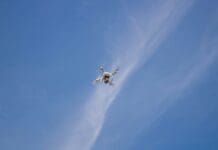This post is also available in:
 עברית (Hebrew)
עברית (Hebrew)
First responders might lose their lives due to poor situational awareness in areas they are being deployed. It’s hard to tell without actually being right there that a toxic gas is lying close to the ground, or that there is a downed electrical line hidden under a fallen tree.
Robots are well-suited to this type of reconnaissance, but it’s a bit of a Catch-22: You have to get close to deploy a robot, but you need the robot there to get close enough in the first place. Unless, of course, you can somehow deploy the robot from the air.
The startup Squishy Robotics has recently exposed its new robotic solution. Co-founder and CEO Alice Agogino told techcrunch.com that the project connected to NASA was originally designed to drop a robot from a spacecraft. However, the company identified the need of first responders to deploy ground sensors before they get to a scene, to know what they’re getting into; then when they get there they want something to walk in front of them.
The final product can fall from 600 feet (some 180 m), and likely much more than that, and function perfectly well afterwards, thanks to its unique “tensegrity structure.”
“We looked at lots of different tensegrity structures — there are an infinite number,” Agogino said. The device “has six compressive elements, which are the bars, and 24 other elements, which are the cables or wires. But they could be shot out of a cannon and still protect the payload.”
Inside the bars are wires that can be pulled or slackened to cause to move the various points of contact with the ground, changing the center of gravity and causing the robot to roll or spin in the desired direction. A big part of the engineering work was making the tiny motors to control the cables, and then essentially inventing a method of locomotion for this strange shape.
“We used machine learning and AI techniques to come up with an optimum technique. First we just created lots of motions and observed them. And from those we found patterns, different gaits. For instance if it has to squeeze between rocks, it has to change its shape to be able to do that.”
The mobile version would be semi-autonomous, meaning it would be controlled more or less directly but figure out on its own the best way to accomplish “go forward” or “go around this wall.” The payload can be customized to have various sensors and cameras, depending on the needs of the client — one being deployed at a chemical spill needs a different loadout than one dropping into a radioactive area, for instance.1


























